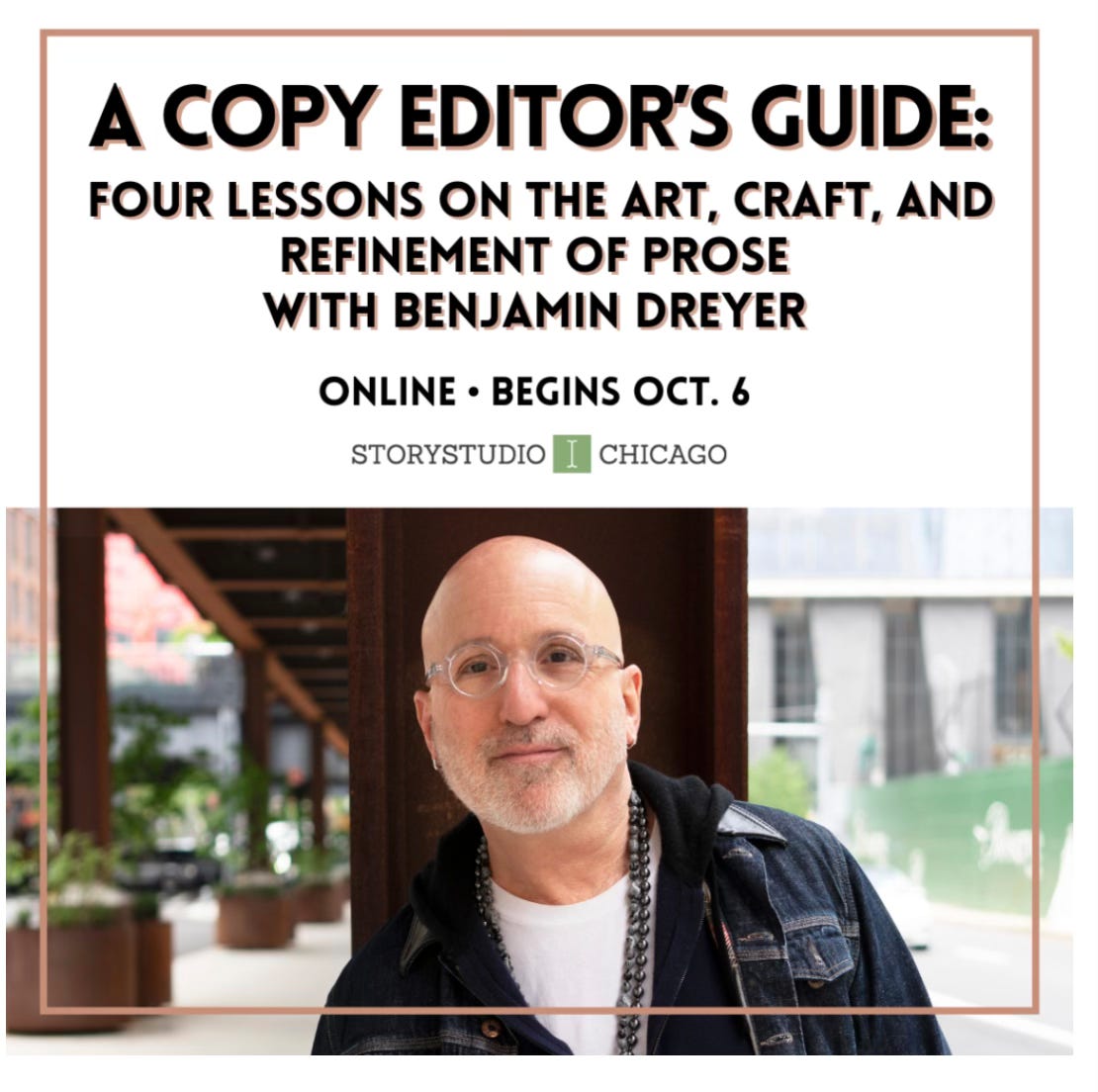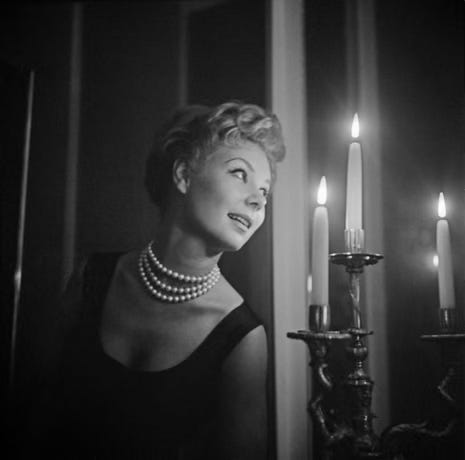Diary of a Mad Copy Editor (part 1)
[a demystification]
Before I forget!
Starting early next month, I’ll be teaching a four-part copyediting course for the fabled StoryStudio1 Chicago, and I hope that I’ll see at least some of you—or even all 21,000 of you—there!
As I was saying, or as I was about to say:
I had cause the other day to riffle through a manuscript I copyedited quite a few years ago, and it occurred to me, particularly as I’m currently neither irked nor enthralled by some modish new coinage and there are no objets lying around in plain sight here to inspire fresh rhapsodies in me, that it might amuse and/or edify you to walk through a bit of the copyediting process with me. For all I know this intended series may go on for quite a while, but as there’s, they tell us, no better place to start than at the very beginning,2 let’s get started.3
First, Do No Harm. Also: First, Read a Bit.
On a scale of helpful to advisable to mandatory, it is crucial to read a bit of what you’re about to start fixing before you start fixing it. I tend to read a good thirty or forty pages of any manuscript I’ve been assigned to work on with my hands very much—figuratively—behind my back. This allows you—you the copy editor, that is—to get a feel for the text, for the voice, for the storyline, for the author’s punctuational tastes, etc. That is: You are listening. And not to sound all woo-woo about it, but you are also beginning to internalize what’s in front of you, aligning, at least to some extent, the author’s brain and your own. In copyediting, your role is to serve the author, to—as I often say—do your best to help make a book into the best possible version of itself that it can be. Of itself, I underline.4 You’re not there to turn a book into something it is not,5 or to corral it into some abstract notion of Correct Prose, or, worse, to transform it from the book its writer6 has written into the book you would have written had you been the writer, which you certainly are not.7
In any event, reading that good thirty or forty pages should give you—you the copy editor, that is—a decent sense of what you’re up against. Quite possibly, to be sure, you’ve already begun to take note of glitches, errors, tics, and other things that may cause your nose to wrinkle, but: They’ll keep. Just read.8
Welcome to Its World.
The morning of June 27th was clear and sunny, with the fresh warmth of a full-summer day; the flowers were blossoming profusely and the grass was richly green.
Oh, look, it’s the opening line of Shirley Jackson’s “The Lottery,” and we’re the copy editor! How thrilling!
But let’s not let our excitement blind us to the work to be done, because we already have some things to mull over.
First we note: “June 27th.” Not “June 27,” which one might expect to see in nonfiction,9 and not “June twenty-seventh,” which might have been a choice the author might have made, except she apparently didn’t.10 To me, “June twenty-seventh” looks a bit once-upon-a-time chattier and “June 27th” looks a bit more, well, calendrical, but back to the “do no harm” notion: The author has (again, apparently) made a decision, and our immediate instinct should not be to contradict her. Will we keep an eye open for subsequent dates and possible inconsistencies in how they’re styled? Sure. But let’s just, for the moment, follow the author’s lead.11
Now, and this is key: If this were the first line not of a short story but of a 300-page novel (or a three-hundred-page novel), the wise copy editor would be thinking: Aha. What year is this? What day of the week are we talking about? Because if a narrative is beginning with a day and/or a date, we may well expect that it’s going to continue with further days and/or dates, and we’ll have to keep track of their progress.
And that’s when and where a perpetual calendar comes in mighty handy.
Now, we don’t know for certain that “The Lottery” is set in 1948, the year of its publication, though the fact that the story appeared in the June 26, 1948, issue of The New Yorker suggests, at least, that we’re meant to see it as tomorrow’s news,12 but let’s just take note that June 27, 1948, was a Sunday, which is, to be sure, the perfect day for a village gathering.13
But whether or not the manuscript we’re working on must be set in a specific year,14 there’s no doubt that time, at least standard Earth time, proceeds logically, and if our author informs us that their first chapter begins on a Sunday morning in June, then everything must indeed follow tidily from that point and the wise copy editor is keeping an eye on phrases like, for instance, “three days later,” not to mention references to local seasonal foliage, high and low tides, and sunrise and sunset and the like.15
Well, that was a lot of initial throat clearing and “let’s get started,” and there’s so much more to expand upon, from the danger of pet words and inadvertent rhymes to the presentation of exposition, &c., &c., and &c., so let’s pause here. We’re none of us going anywhere, at least I’m not.
Back soon.
Thank you, as always, for being here, with particular thanks to subscribers both free and paid, the latter of whom truly—truly—keep this enterprise chugging along.
Sallie the summer16 dog is grateful too.
Today is the first posthumous birthday of the glorious Mitzi Gaynor, and that’s a perfectly good reason to think about her and celebrate her (though I’ve been known to think about her and celebrate her far more than once a year). So let’s.
Cover painting: Gustave Courbet, Le Désespéré (1843–45)17
As you quite possibly already know, this type of construction—that is, a compound-type fused noun commencing with a capital letter and also including a capital letter or two (InSinkErator, for instance) in its midst—is called camel case. Or, if you prefer to sound a bit more scholarly, you can learnedly refer to medial capitals. If your construction begins with a lowercase letter, as in iPhone or eBay, that’s often called lower camel case or dromedary case.
A very good place to start, Oscar Hammerstein II reminds us.
To be sure, the identity of the particular manuscript is not anything like the point here, and its identity will not be revealed, and no doubt I’ll disguise, alter, and otherwise finagle my way around some particulars to throw you sleuths off the scent, but the essentials will be essentially accurate and honest. And, to be sure, as you’re about to see, I may well allude to other works of prose. All in all, the process is the process, and though one manuscript is rarely anything like another, copyediting is copyediting.
Or at least italicize.
Well, I’ll get back to that notion in a sec.
I tend to use the terms “writer” and “author” interchangeably. One could, I suppose, make the argument that writers write and authors have been published, but I don’t care to make that argument. Though I am reminded of the venerable gibe about how the difference between a politician and a statesman is that politicians are alive and statesmen are dead. (Occasionally followed by something along the lines of “What this country needs is more statesmen.”)
We’re proceeding, by the bye, under the assumption that the manuscript we’re working on is at least competent. Coping with bad writing can be tedious, infuriating, or even nightmarish. I’m thinking just this moment of a manuscript I was hired to work on decades ago, with the express and expressed request from its editor—who had, I was told, exhausted himself in his attempts to fix what was wrong with it, which proved to be plenty—that I do anything and everything I felt like doing to improve it. And so I rolled up my sleeves and indeed did anything and everything, and Lord knows I wasn’t being paid nearly enough, but I was relatively young and reasonably arrogant and thought that I was going to make something marvelous happen. And you know what? When I got my hands on a copy of the finished book, whose text I had more or less rewritten, it was still perfectly awful. Somewhat better than it had been, but still: perfectly awful. There’s a lesson there.
“The trouble with washing garbage is that when you’re done, it’s still garbage.” —Sheldon Harnick
In our modern Word file era, copy editors can easily rethink anything they’ve done or suggested over the course of the job and make their changes or queries vanish with a click of a button. Back in the paper day, though, the rethinking of executed copyediting would lead, perforce, to erasing—with, indeed, a dedicated eraser; the erasers on pencils tended to be feckless—and all sorts of smudges, pentimentos, and the occasional tear in the paper would ensue, and (I confess) the irritating arduousness of that process would on occasion lead me to stubbornly stand by a change I was less confident in than I had been rather than go to the trouble of discarding and/or replacing it. It’s one of the reasons that, loath as I was back in the day to switch from paper copyediting to electronic copyediting—largely because I detest change, and at least in part because the process was, in its infancy, clumsy and galumphing—I’ve come to revel in our brave new processes. Plus my desk isn’t covered with pink shreds at the end of the day anymore, and neither are my fingers stained with green pencil. (I never liked working in red. It’s scoldy.)
That said, I would, in the old days, if I’d been hired to work on a mystery or thriller-type novel, read the entire thing from front to back, because plot twists and revelations can wreak havoc on a copy editor’s assumptions. Now, of course, you can make your way through the plot, enjoy the occasional surprise, and, having been beautifully misled, go back and hide all the evidence of your misapprehensions.
Or “27 June,” even, if we live elsewhere than in the United States.
I don’t, to be sure, have SJ’s initial typescript in front of me, so I can’t be sure how she herself typed that date, except I might be reasonably certain, given her penchant, with which I’m familiar, for typing in all lowercase, that she typed “june” rather than “June.” But let’s proceed with the assumption that what we’re looking at in the published story reflects her intentions at least as much as the intentions of The New Yorker’s copy desk.
Sometimes, believe it or not, authors know what they’re doing. And sometimes, amazingly enough, they like things to be published more or less the way they wrote them. Go figure.
I’m also recalling, less rather than more vaguely, that SJ was asked by the magazine to align the date of the story with its publication.
Unless your name is Tessie Hutchinson.
Also, I’ve just done a quick search of the text of the “The Lottery,” and unless I’m overlooking something, SJ doesn’t explicitly note what day of the week it is. (I note the passing reference to the villagers getting home in time for “noon dinner,” which sounds very Sunday to me (who’s never lived in a village or ever had dinner earlier than oh, say, 5:30), but one also notes that at the end of June, school’s out—as SJ reminds us. So I suppose it might (?) be any day of the week. If you happen to be rereading the story and see any other clues, please feel free to shout ’em out.)
I once spent a good twenty pages and a lot of brain cells trying to infer from bits and pieces of exposition in what year a novel I was getting to work on took place, and it finally occurred to me to simply phone the author (a copy editor doesn’t always have such ready access to an author, but in this case I did) and ask. “Hi, what year are we in, please?” “Nineteen ninety-eight.” “Thanks.” *Click.* That was easy.
If we’re in, say, Vermont on June 27, the sun rises at 5:10 in the ayem and sets at 8:41 in the evening; you can look it up, and of course you do.
Beyond that, we’ve also taken note of the presence of a semicolon (Author uses semicolons, we note), and the absence of a comma where we might possibly expect to find a comma in “the flowers were blossoming profusely and the grass was richly green” (that is, between “profusely” and “and”). (Author likes punctuation and clearly has made some decisions about how to wield it, we further note. So though we may be mindful, going forward, of places where one comma more or less might assist clarity, we should be careful not to fuss with the author’s punctuation for the mere sake of fussing with it.
Unless, that is, there’s a place where a series comma might go and isn’t yet present. Because, if so, it’s about to be present. Only savages, as someone once commented, eschew the series comma.
It’s still summer for another two and a half weeks.
En dash alert!






I once noted to an author that she seemed to insert commas almost randomly. "Yes," she agreed with a touch too much delight, "I toss them in like little ninja stars."
As usual, the footnotes were as entertaining as the body was educational.
In footnote 1, I learned a new terminology for mixed cases. (Dromedary! Aha!)
Back to the text for a moment, I was impressed by the split infinitive you provided:
"to—as I often say—do" .
Footnote 5: I am in agreement with the need for more statesmen.
Footnote 7 made me wonder: in the good old days, did you actually have to erase what you wrote? Couldn't you line through or color over the errors with the writing end of your instrument? Or is it that you would rather leave no evidence?
I look forward to parts 2 et seq. And to your on-line seminar as well.